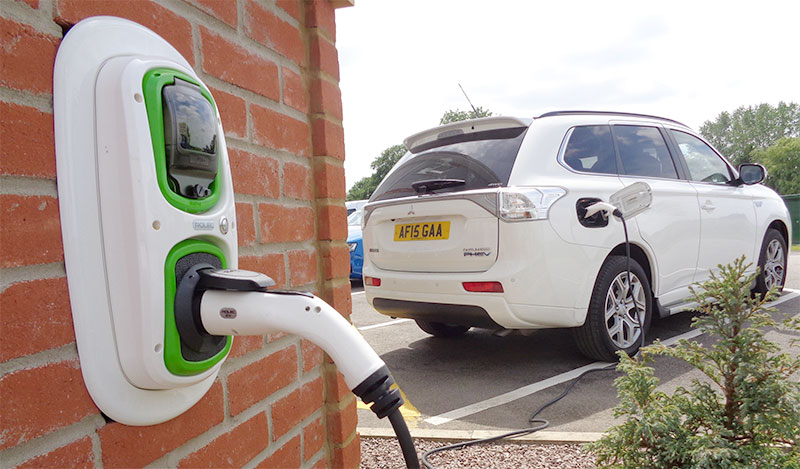Sales of gasoline and diesel vehicles will continue to fall throughout the world as electric vehicles (EVs) increasingly claim a bigger share of the global market for passenger cars, buses and light commercial vehicles, while grabbing a significant share of the international market for short-distance trucks and vans, according to the latest annual forecast by BloombergNEF (BNEF).
“Our conclusions are stark for fossil fuel use in road transport,” said Colin McKerracher, head of advanced transport for BNEF.
In its Electric Vehicle Outlook 2019 report, BNEF claims that EVs could account for as much as 57% of all passenger car sales throughout the world by 2040, up slightly from its forecast last year. The research firm expects electric buses to account for 81% of municipal bus sales within the same time frame.
BNEF predicts that global passenger EV sales will jump from 2 million last year to 28 million units in 2030 and 56 million by 2040. It expects worldwide sales of traditional passenger vehicles to fall to 42 million units by 2040, from about 85 million in 2018.
It sees policy support measures and China’s ambitious EV rollout as the main global growth drivers over the next five to seven years. But by the second half of the 2020s, the ongoing decline of lithium-ion battery costs will start to become a significant driver for worldwide EV uptake, as well as the deployment of stationary energy storage applications.
Sliding battery costs
Over the past decade, the average cost of lithium-ion batteries per kilowatt-hour has plunged by 85%, due to economies of scale and continual technology improvements. As a result, BNEF expects EVs to be cheaper than vehicles based on internal combustion engines by the end of the 2020s in nearly every market in the world, based on upfront and lifetime costs.
“Electrification will still take time because the global fleet changes over slowly but, once it gets rolling in the 2020s, it starts to spread to many other areas of road transport,” said McKerracher. “We see a real possibility that global sales of conventional passenger cars have already passed their peak.”
BNEF believes that EVs will add 6.8% to worldwide electricity usage in 2040, pushing demand for lithium-ion batteries from 151 GWh this year to 1,748 GWh by 2030. However, it notes that the development of new mining capacity will be critical in ensuring that all materials used in lithium-ion batteries are available in sufficient quantities to support production.
It expects China to maintain its global lead in EV use, accounting for 48% of worldwide passenger EV sales by 2025 and 26% by 2040, by which point many other countries will start putting more EVs on their own roads. Europe will be the world’s second-biggest EV market throughout the next decade, ahead of the U.S. market. Outside of China, the electrification of transport will be considerably slower in many countries, BNEF said, leading to what it describes as a “fragmented global auto market.”
In markets like India and South East Asia, two- and three-wheeled vehicles are more attractive targets for electrification in the short term. However, around year 2025, EV adoption in India will pick pace, reaching close to 30% of passenger vehicles sales by 2040.
This year’s study marks the first time that BNEF has looked at the commercial vehicle market. It believes that within the next 20 years, electric models will account for 56% of light commercial vehicle sales in Europe, the U.S. and China. It expects electric models to grab roughly 31% of the medium commercial market over the same time period.
Disruptive change
However, EV manufacturers will struggle to penetrate the global market for heavy trucks, with BNEF projecting that electric models will only account for 19% of global sales in the segment by 2040. The research firm expects that most electric heavy trucks will be used for shorter-distance applications, but notes other alternatives to long-haul heavy trucks that could become increasingly viable in the future, such as vehicles that use natural gas and hydrogen fuel cells.
It also expects shared mobility services, including car-sharing, to play a key role in the changing global vehicle market. Such services currently account for under 5% of all passenger miles travelled throughout the world, but BNEF believes that could jump to 19% by 2040. It notes that it does not see autonomous driving applications to start significantly reshaping global transport until the 2030s, however.
“Transport is moving into a period of disruptive change, with many different factors coming into play,” concluded McKerracher. “We have incorporated several new elements into our analysis, including an updated EV cost model that includes the cost of a home EV charger to reflect more accurately the costs individuals face to go electric; and a battery chemistry forecast for each of the new segments covered in this year’s report.”
This content is protected by copyright and may not be reused. If you want to cooperate with us and would like to reuse some of our content, please contact: editors@pv-magazine.com.








By submitting this form you agree to pv magazine using your data for the purposes of publishing your comment.
Your personal data will only be disclosed or otherwise transmitted to third parties for the purposes of spam filtering or if this is necessary for technical maintenance of the website. Any other transfer to third parties will not take place unless this is justified on the basis of applicable data protection regulations or if pv magazine is legally obliged to do so.
You may revoke this consent at any time with effect for the future, in which case your personal data will be deleted immediately. Otherwise, your data will be deleted if pv magazine has processed your request or the purpose of data storage is fulfilled.
Further information on data privacy can be found in our Data Protection Policy.